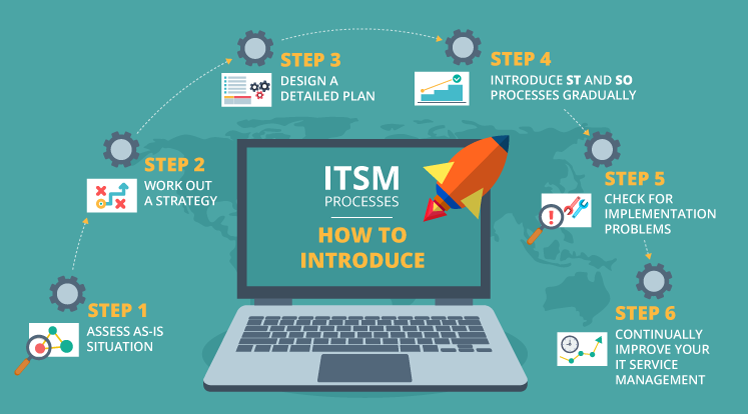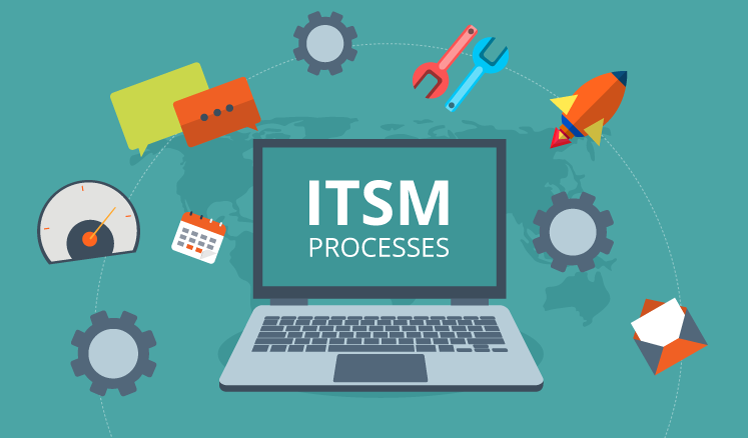Editor’s note: This is a general overview of what ITSM processes are and what they can bring to a company.
Here at SCS Tech, our ITSM consulting team believes that the less chaos in one’s IT infrastructure, the better. And this belief proves to be right with the fact that establishing stable and efficient IT operations is one of the reasons for companies from all over the world to adopt ITSM processes. But what are these ITSM processes and why else would a company want to adopt them? We will go through that in detail below, but let’s briefly clarify the difference between ITSM and ITIL first.
ITSM is a widespread ideology – a “religion” as some of my colleagues say – of managing IT in an organization by delivering it as a service.
ITIL is the most popular approach to ITSM, a documented set of best practices for running IT within an organization that is built around certain ITIL processes.
ITIL processes are often dubbed “ITSM processes,” so for the sake of convenience, I’ll use the ITSM processes term throughout this article to refer to ITIL processes.
What ITSM processes actually are
SCS Tech team of ITILv3-certified experts applies ITSM processes in their daily work and implements them for our customers according to the following 5 stages:
Service Strategy (SS) is the first and foremost stage. Here, you determine what exactly your IT does, explore what your users/customers need and verify whether the IT service is worth it financially. Broadly speaking, SS contributes to the overall understanding of your IT services. Some of the processes here: Service Portfolio, Financial Management, Business Relationship Management, etc.
Service Description (SD) is the ‘helping hand’ of Service Strategy. It complements strategic findings with a detailed documented description of your services. SD ensures that your IT service delivery will meet the needed requirements, your company will have enough capacity to deliver the services, and these services will be available, secure, etc.
Service Transition (ST) is responsible for the conversion of your services from paper into real action. Apart from that, ST maintains your services as stable and undisturbed as possible, while allowing them to be dynamic by carefully introducing changes. The processes at this stage, for instance, are Change, Release and Knowledge Management.
Service Operation (SO) makes sure your services work, and disruptions get solved promptly. There are 5 main processes that help SO do that:
- Event Management: Monitors how services run. In case of trouble, it notifies you and aims to resolve it.
- Incident Management: Aims at restoring the normal flow of IT processes as soon as possible. If something isn’t working properly, IT guys implement a quick solution, for instance, a reboot.
- Problem Management: Deals with the underlying cause of incidents. If any problem is detected, the IT team analyzes why it appeared and how it can be solved properly, so that no similar incidents occur in the future.
- Request Fulfillment: Tries to take some load off Change Management in ST and deals with low-risk repeated and pre-defined situations. For example, when a newcomer needs a computer installed, an account created, etc.
- Access Management: Deals with accounts and passwords. Since password resets are the most common inquiries within Access Management, this process can enable a company with, say, 600,000 annual password resets to save as much as $1,850,000 per year by automating the fulfillment of such inquiries. And such savings are not uncommon among our ITSM implementation customers.
According to our experience of implementing and supporting ITSM solutions for our customers. Incident Management and Request Fulfillment are the most popular processes of the SO stage.
Continual Service Improvement (CSI) is the last stage aimed at achieving the constant perfection of your services. To do that, your organization needs to monitor IT performance and react to its problem areas.
Thinking Of Going ITSM?
Grasping the theory behind ITSM processes is good, but now is the time for you to turn to SCS Tech and see for a fact what ITSM will bring to your organization!
What ITSM processes bring
Being a very structured approach to IT services, ITSM can bring lots of benefits. But the other side of the coin shouldn’t be neglected too.
The Good
The good side of ITSM processes is that they bring clarity and transparency to your IT structure. But is there something else behind these vague words? Yes, there is. Here is what customers cite as the most prominent outcomes of introducing ITSM in their orgs:
- ITSM processes help IT departments stabilize IT service availability. Armed with clear what-and-how guidelines, IT teams reduce downtime (when disruptions in services occur) and increase service availability.
- The decrease in IT teams’ reaction and resolve time, as well as the increase in overall service availability, improves user/customer satisfaction rate.
- A more effective approach to daily operations and the automation of some of them reduce IT service management costs.
- ITSM processes ensure that IT services are solid as a rock and at the same time aren’t resisting change. Release and Change Management help achieve ‘cautious’ IT dynamics within the enterprise.
The Evil
Although SCS Tech helped them in the end to find solutions to each point in the ‘dark side’ of ITSM, our customers do admit that often there was some resistance in their midst regarding the introduction of ITSM processes. Here are some of the ‘evil things’ about ITSM that caused this resistance:
- Introducing ITSM processes was viewed as ‘too big of a change’ since it required a lot of time and effort. But most importantly, it required a change in their employees’ way of thinking. And so, learning the new workflows was met with considerable resistance. As a compulsory condition for success in such cases, we see not only the need to have the IT personnel change their approach but also the need to educate the company’s management.
- Once our customers decided to adopt ITSM processes, they saw that the processes were actually expensive to introduce.
- At some point, to support ITSM, a company needs to use specific software. Free tools don’t incorporate all ITSM processes and aren’t free to maintain. Mid-level platforms aren’t that expensive but still lack needed functionality. And comprehensive ITSM systems can cost a small fortune. The choice can be overwhelming, but having SCS Tech as an ITSM consultant at their side, our customers managed to easily find a fit solution.
- A company needs to invest in organizing training for staff to teach them the core concepts of ITIL and also may have to additionally organize training for the users of the new ITSM platform.
- Some of the ITSM processes (especially, Change Management) bring the element of ‘bureaucracy’ into the work of IT departments. It happens with practically every complex hierarchical structure and is an aftereffect of the IT process formalization.
The Balance
Despite all the ‘evil’ that ITSM processes can bring, SCS Tech customers are inclined to think that ITSM is on the light side of the force. Obviously, a company needs to invest in changing their IT structure while introducing ITSM processes. But the benefits (the improvement of IT service delivery and reduced IT support costs) will soon outweigh the difficulties of the implementation process.
How SCS Tech introduces ITSM processes
Here is a high-level outline of how SCS Tech ITSM experts usually introduce ITSM processes in our customers’ organizations. Note that this outline does not apply to all cases of introducing ITSM and is subject to change under the specific conditions of a particular customer.
Step 1: We assess the as-is situation.
Step 2: We work out an ITSM introduction strategy.
Step 3: We design a detailed plan.
Step 4: We gradually introduce ST and SO processes (incident – problem – configuration – change – SLA).
Step 5: We check for implementation problems (for example, set up mechanisms for controlling the usage of newly implemented processes so that all the effort isn’t in vain).
Step 6: We continually improve IT service management and start to prepare for going to the next level of ITSM maturity when the customer is ready.

Our ITSM experts think that the key idea here is that no company should try to grasp it all at once. The transformation process has to happen carefully, with one step at a time, achieving specific small-scale goals (reducing operational costs or increasing first-response time). If you have trouble with that, turn to our ITSM consultants to identify your small-scale and forward-looking goals that would be a good place to start your ITSM journey.










